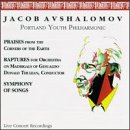| All Artists: Jacob Avshalomov, Portland Youth Philharmonic Title: Jacob Avshalomov: Symphony of Songs, etc. Members Wishing: 0 Total Copies: 0 Label: Albany Records Release Date: 11/29/1995 Genres: Special Interest, Pop, Classical Styles: Vocal Pop, Opera & Classical Vocal, Historical Periods, Modern, 20th, & 21st Century, Symphonies Number of Discs: 1 SwapaCD Credits: 1 UPC: 034061016021 |
Search - Jacob Avshalomov, Portland Youth Philharmonic :: Jacob Avshalomov: Symphony of Songs, etc.
 | Jacob Avshalomov, Portland Youth Philharmonic Jacob Avshalomov: Symphony of Songs, etc. Genres: Special Interest, Pop, Classical
|
Larger Image |
CD Details |
CD ReviewsMusic of Individual Character Thomas F. Bertonneau | Oswego, NY United States | 06/07/2001 (4 out of 5 stars) "Born in Tsingtao, China, in 1928, Jacob Avshalomov came to the United States in the 1930s, studied with Ernst Toch, won a prize for his opera "The Taking of T'ung Kuan" in 1952, and later settled in for a long, long stint as conductor of the Portland Youth Philharmonic - the ensemble heard in the Albany CD under review. Avshalomov leads the young players in a trio of his own works. A word first about the performances, all of which were recorded in concert. It's a "youth symphony," not a fully professional orchestra; it sometimes shows intonation problems and can be slow to pick up cues from the baton. As training orchestras go, however, it's pretty good. I remember a CRI LP of Avshalomov and the PYP doing Ernest Bloch's Trombone Symphony and his Suite Classique. Those are thorny scores and the musicians did a convincing job with them. They do the same here. Avshalomov's music resembles Bloch's, assimilating Jewish, Chinese, American-Indian and other influences in a neo-Romantic idiom spiced by occasional bitonal harmonies; he orchestrates with an ear for attractive sonorities. "Praises from the Corners of the Earth" (1964), a symphony for orchestra and chorus, sets texts taken from John Donne, the Koran, e. e. cummings, and Chief Joseph Strongwolf. It's the kind of music that would make a good impression in the Hollywood Bowl on a warm night, not only because the texts laud the beauties of the fair earth, but because the openness of the music suggests the ethos of clear air and a beneficent nature. I find it immediately attractive. "Raptures for Orchestra on the Madrigals of Gesualdo" (1982) directly quotes its source, using the chorus, at the beginning of each of its three movements and then develops Gesualdo's music instrumentally and chorally in Avshalomov's idiom. The technique is related to that in William Schuman's "New England Triptych" after hymns of William Billings and might owe something in conception to Ottorino Respighi's Gregorian pastiches of the 1920s and 30s. Only modesty prevents Avshalomov from calling "Raptures" a symphony; it is a better organized and more pleasing score than many another under the name of symphony. Purely instrumental, the "Symphony of Songs" (1994) takes its title from the fact that each of the five movements develops the material of one of Avshalomov's voice-and-keyboard songs. At thirty minutes, "Symphony of Songs" beats the two other works in scale, although it strikes me as slightly less distinctive (or less pithy) than its companion-pieces. Nevertheless, it has its merits, enough of them to have made me listen through it twice in succession. This disc reminds us that there are dozens of American composers of the mid-century who wrote attractive music that is now unknown or all but unknown. Thanks to the people at Albany for making this music, in these performances, available."
|

 Track Listings (11) - Disc #1
Track Listings (11) - Disc #1